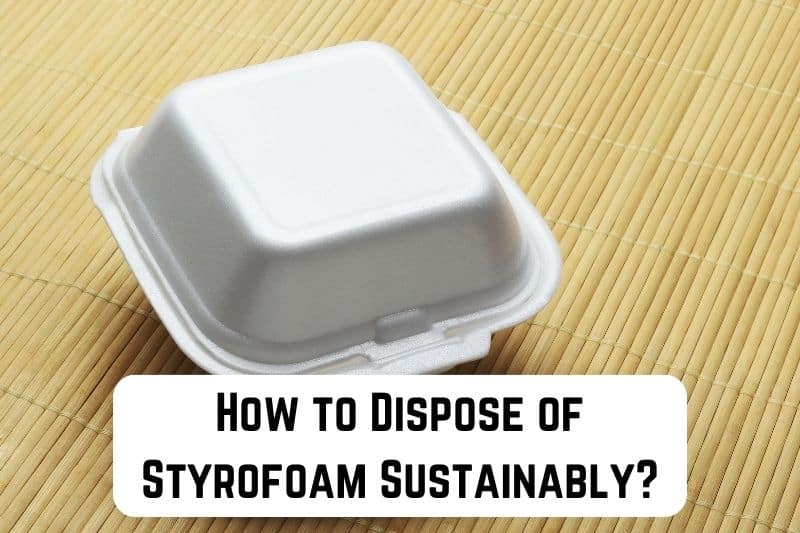Styrofoam is very popular in many industries, including the food business, logistics, packaging, marine, and boating. It has great insulating properties despite its light weight. It is also durable, can absorb impact, and can be used in different ways, making it versatile.
Styrofoam is an expanded polystyrene foam (EPS) used for various functions. It is made from expanding polystyrene resin beads using heat and a blowing agent like steam. The polystyrene beads fuse after expanding through the heat and steam process to form a rigid structure with small closed-air cells and can be molded into different shapes for various uses.
Given the multiple uses of styrofoam in our day-to-day lives, styrofoam must be disposed of in an environment-friendly way. Read below about the ways to dispose of styrofoam.
Why Should Styrofoam be Disposed of in an Eco-Friendly Way?
The primary concern about styrofoam is its disposal, as many negative consequences can arise from disposing of styrofoam wrongly.
Although styrofoam is a valuable compound with various applications, its environmental concern has been significant enough for many people to push for options. Styrofoam is non-biodegradable, and dumping it wrongly into the environment can cause much harm.
Preventing Environmental Pollution
Styrofoam is made from a chemical compound and is non-biodegradable. That means it cannot degenerate no matter how long. Therefore, disposing of styrofoam can cause land pollution and landfills. This can affect the environment negatively and upset the ecosystem balance.
Also, disposing of styrofoam can lead to flood, water contamination, and stagnation, among others. Therefore, it is essential to dispose of them in the right ways to prevent problems for the environment.
Preventing Chemical Leaching
As stated earlier, styrofoam is made from a chemical compound that does not degenerate. This means the chemical remains in the styrofoam even after years of production.
Dumping the styrofoam carelessly after use can cause this chemical to leach into where the dump is. This, in turn, can lead to land or water poisoning, which can affect the fertility of the land or the potability of the water. Therefore, it is essential to dispose of styrofoam correctly to prevent chemical leaching and its side effects.
Wildlife Conservation
Wildlives can ingest small styrofoam particles, mistaking them for food, when they are disposed of wrongly. This can cause problems for their health, leading to their death, and therefore, decrease.
Also, styrofoam pollution can lead to wildlife habitat destruction, making their homes unsuitable for them and making it more difficult for them to live in. Therefore, you should ensure to dispose of your styrofoam in the responsible manner discussed in this article to prevent disrupting the ecosystem and causing harm to wildlife.
Sustainability
Styrofoam is made from a finite resource that can go extinct if continually derived. Therefore, it is important to manage the resources well to ensure they are not used up, as they cannot regenerate themselves.
Recycling, which is one of the eco-friendly ways of disposing of styrofoam, can help ensure that you can reuse the available styrofoam rather than make new ones for every single need and overstress the resource.
Reducing Economic Cost
The cost of producing styrofoam is quite high, unlike recycling or reusing available ones. Therefore, employing these methods to dispose of styrofoam is great as they will also help conserve money. The conserved funds can be diverted to other things, making it easy to achieve more than enough with the available financial resources.
Aesthetics
Continual dumping of styrofoam will make the dumpsite look rough and dirty. This will reduce the aesthetic appeal of the environment, reducing its value and leading to a loss of respect. Therefore, it is essential to employ the right disposal methods for our styrofoam waste as they will help keep the environment clean, appealing, and nice.

Various Ways to Dispose of Styrofoam
Disposing of styrofoam correctly can prevent pollution, conserve resources, and lead to economic gain. Although styrofoam is non-biodegradable, there are ways to dispose of it without harming the environment.
There have been many campaigns against using styrofoam due to its possibility of harming the environment. However, its numerous benefits should not be discarded because of how stressful its disposal is. Instead, there are numerous beneficial ways you should consider for styrofoam disposal. They include:
Recycling
Recycling is an ideal and one of the best ways to dispose of styrofoam in an eco-friendly way. Recycling helps reduce waste, save energy, conserve resources, and keep the environment clean. Most communities have provisions for recycling styrofoam; all you have to do is prepare it and get it to the appropriate recycling center or drop-off location.
You can also attend local collection events to enable them to recycle your styrofoam waste. Styrofoam wastes can also be processed with foam densifiers, making them suitable for easy transportation.
Reuse
Reusing is another cost-saving and resource-conserving method of disposing of styrofoam in an eco-friendly manner. Not only does it protect the environment without people having to spend more, but most styrofoam leftovers can also be used in multiple ways.
For instance, you can use styrofoam waste that is still neat to repackage and ship fragile items. You can also use it to make insulation lining in different processes, including construction.
Moreover, an easy DIY use of styrofoam is to make arts and crafts from it. You can check the internet or YouTube for ideas on turning your trash into beauty. You can also use styrofoams for home organization, soundproofing, making floating devices and protective cushions, gardening, etc.
Donations
Do you want to take care of your styrofoam waste in a clean and resource-conserving manner while doing a good deed simultaneously? Then, consider donating it. You can donate your styrofoam waste to community and non-profit organizations, educational institutions, reuse centers, local businesses, etc.
Ensure that the foam you want to give out is in good and usable condition before donating. Also, check out the place you wish to donate to to ensure it is feasible for their needs.
Manufacturers’ Take-Back Programmes
The manufacturer’s take-back programs are the result of efforts of styrofoam manufacturers to ensure they are responsible for the styrofoam beyond the first sell. Styrofoams are non-biodegradable and have been posing worries to environmentalists. In fact, many people have called for a ban on styrofoam, and regulations are in place to reduce their use.
Therefore, it is understandable that the manufacturers are stepping up to appropriately manage them for a long time to ensure people stop seeing styrofoams as threats to the environment.
Can You Burn Styrofoam?
Burning styrofoam may seem like the easy way out. However, it comes with dire consequences and can create worse problems.
Many people recommend burning styrofoam as they feel it is a convenient disposal method due to its lightweight and flammable nature. However, this is not a good and eco-friendly way of disposing of styrofoam.
Some people are unaware of the environmental hazards this act can bring to them and society. While burning will help you eliminate the cumbersome styrofoam, it will create other problems instead.
Burning styrofoam will release toxic fumes like carbon dioxide, styrene, and other hazardous compounds into the atmosphere. These compounds can pollute the air, make the air unclean, and cause health issues related to breathing in toxic fumes.
Also, burning styrofoam can pollute the land the act is done on and any water body near it. This makes both the land and water unfit and useless.

Why is Styrofoam Not Recyclable?
Styrofoam recycling takes a lot but may not yield results to complement the effort so it is generally considered unpredictable.
This is because of the many hassles involved in trying to recycle them. Recycled styrofoam can be used to make various new materials like insulation materials, new foam packaging, picture frames, floating devices, horticultural products, and decorative molding. However, styrofoam recycling comes with a lot of headaches that has made many give up on it.
It is challenging to collect and transform styrofoam because of its lightweight. It takes a lot of space and does not give much product after compression, making recycling it less cost-effective.
Also, styrofoams can be easily contaminated, making them unfit for reuse. They can also spread the contaminants to other things, so they need a thorough quality control process during recycling, which is not affordable.
Lastly, there is a limited market for recycled styrofoam. This means that a recycler can go through all the efforts involved in recycling it and not be able to recoup their investment in the process.
Is it Better to Burn Styrofoam or Throw it Away?
Both burning and throwing away are bad methods of styrofoam disposal. They can harm people’s health and the environment.
As discussed earlier, burning can cause negative effects on the environment and the person burning the styrofoam.
Similarly, throwing away styrofoam can cause pollution and chemical leaching. The major problem is not the temporal pollution this system can cause but the fact that styrofoam doesn’t degenerate and will remain a problem forever.
Conclusion
Although styrofoams can have great and numerous advantages, the disadvantage outweighs the advantage if not properly handled. Styrofoam is made from a non-degradable chemical compound, making it difficult to dispose of. Also, wrong styrofoam disposal has many harms.
Therefore, you should endeavor to dispose of styrofoam the proper way. The good news is that you can use and dispose of styrofoam without harming nature but help conserve resources instead.






